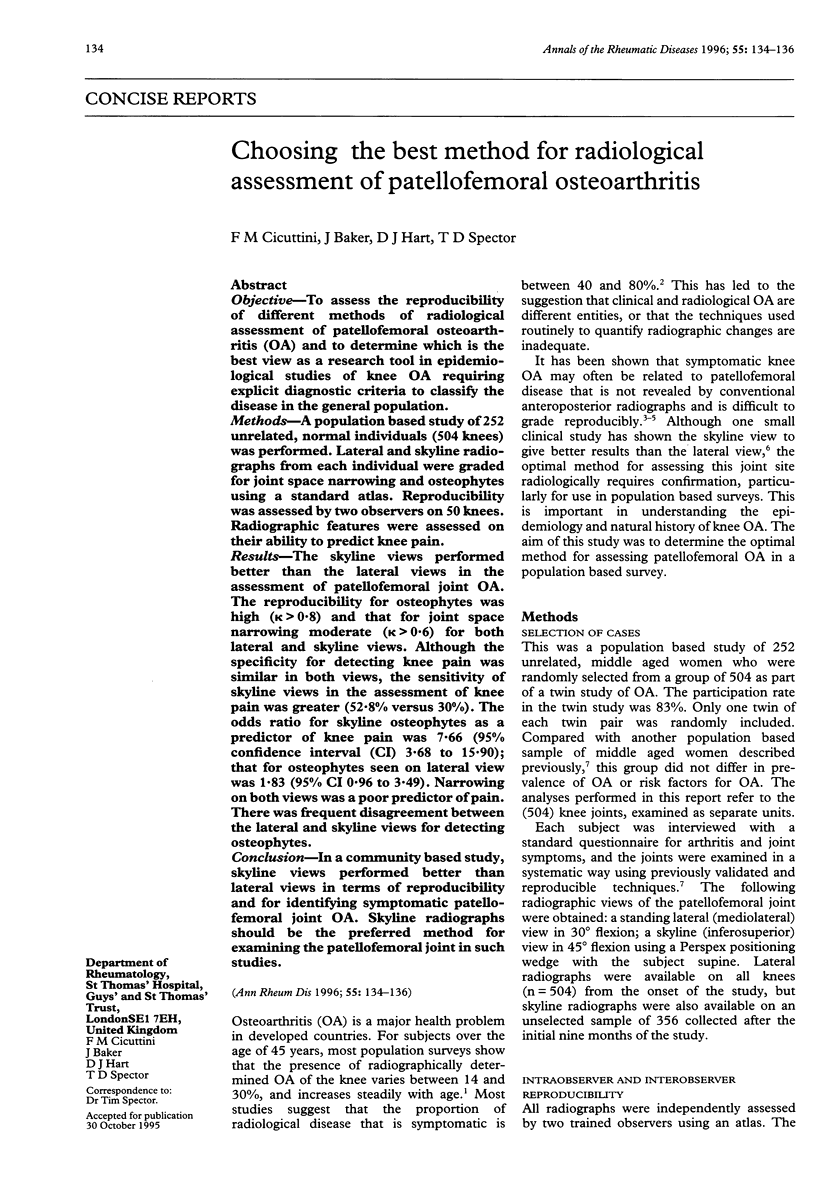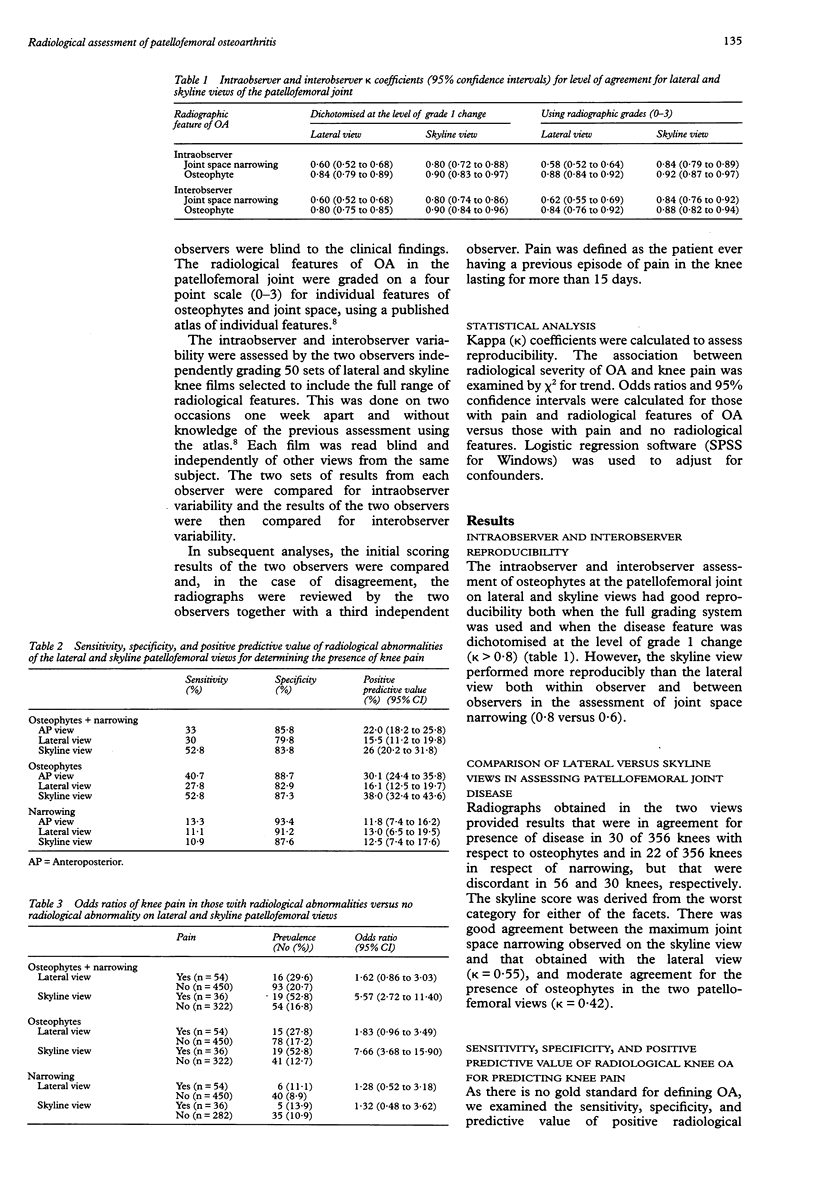Abstract
OBJECTIVE: To assess the reproducibility of different methods of radiological assessment of patellofemoral osteoarthritis (OA) and to determine which is the best view as a research tool in epidemiological studies of knee OA requiring explicit diagnostic criteria to classify the disease in the general population. METHODS: A population based study of 252 unrelated, normal individuals (504 knees) was performed. Lateral and skyline radiographs from each individual were graded for joint space narrowing and osteophytes using a standard atlas. Reproducibility was assessed by two observers on 50 knees. Radiographic features were assessed on their ability to predict knee pain. RESULTS: The skyline views performed better than the lateral views in the assessment of patellofemoral joint OA. The reproducibility for osteophytes was high (kappa > 0.8) and that for joint space narrowing moderate (kappa > 0.6) for both lateral and skyline views. Although the specificity for detecting knee pain was similar in both views, the sensitivity of skyline views in the assessment of knee pain was greater (52.8% versus 30%). The odds ratio for skyline osteophytes as a predictor of knee pain was 7.66 (95% confidence interval (CI) 3.68 to 15.90); that for osteophytes seen on lateral view was 1.83 (95% CI 0.96 to 3.49). Narrowing on both views was a poor predictor of pain. There was frequent disagreement between the lateral and skyline views for detecting osteophytes. CONCLUSION: In a community based study, skyline views performed better than lateral views in terms of reproducibility and for identifying symptomatic patellofemoral joint OA. Skyline radiographs should be the preferred method for examining the patellofemoral joint in such studies.
Full text
PDF


Selected References
These references are in PubMed. This may not be the complete list of references from this article.
- Bagge E., Bjelle A., Edén S., Svanborg A. Osteoarthritis in the elderly: clinical and radiological findings in 79 and 85 year olds. Ann Rheum Dis. 1991 Aug;50(8):535–539. doi: 10.1136/ard.50.8.535. [DOI] [PMC free article] [PubMed] [Google Scholar]
- Davis M. A., Ettinger W. H., Neuhaus J. M., Mallon K. P. Knee osteoarthritis and physical functioning: evidence from the NHANES I Epidemiologic Followup Study. J Rheumatol. 1991 Apr;18(4):591–598. [PubMed] [Google Scholar]
- Hart D. J., Spector T. D. Cigarette smoking and risk of osteoarthritis in women in the general population: the Chingford study. Ann Rheum Dis. 1993 Feb;52(2):93–96. doi: 10.1136/ard.52.2.93. [DOI] [PMC free article] [PubMed] [Google Scholar]
- Jones A. C., Ledingham J., McAlindon T., Regan M., Hart D., MacMillan P. J., Doherty M. Radiographic assessment of patellofemoral osteoarthritis. Ann Rheum Dis. 1993 Sep;52(9):655–658. doi: 10.1136/ard.52.9.655. [DOI] [PMC free article] [PubMed] [Google Scholar]
- Ledingham J., Regan M., Jones A., Doherty M. Radiographic patterns and associations of osteoarthritis of the knee in patients referred to hospital. Ann Rheum Dis. 1993 Jul;52(7):520–526. doi: 10.1136/ard.52.7.520. [DOI] [PMC free article] [PubMed] [Google Scholar]
- McAlindon T. E., Snow S., Cooper C., Dieppe P. A. Radiographic patterns of osteoarthritis of the knee joint in the community: the importance of the patellofemoral joint. Ann Rheum Dis. 1992 Jul;51(7):844–849. doi: 10.1136/ard.51.7.844. [DOI] [PMC free article] [PubMed] [Google Scholar]
- Spector T. D., Hart D. J., Byrne J., Harris P. A., Dacre J. E., Doyle D. V. Definition of osteoarthritis of the knee for epidemiological studies. Ann Rheum Dis. 1993 Nov;52(11):790–794. doi: 10.1136/ard.52.11.790. [DOI] [PMC free article] [PubMed] [Google Scholar]


